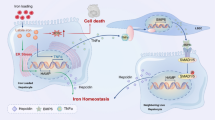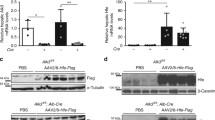Abstract
Hepcidin, a small cationic liver derived peptide, is a master regulator of body iron homeostasis. Cytokines and iron availability have so far been identified as regulators of hepcidin expression. Herein, we investigated the functional role of Kupffer cells for hepcidin expression because of their vicinity to the hepatocytes and their importance for iron recycling via erythrophagocytosis. We investigated C57Bl6 mice and littermates, in which Kupffer cells were eliminated in vivo upon intravenous injection of liposome-encapsulated clodronate. Primary cultures of hepatocytes and Kupffer cells were used to study direct regulatory effects ex vivo. The in vivo depletion of Kupffer cells resulted in a significant increase in liver hepcidin expression, which was paralleled by a significant reduction in serum iron levels. The same pattern of regulation by Kupffer cell depletion was observed upon injection of bacterial lipopolysaccharide into mice and in primary (Hfe −/−) and in secondary iron-overloaded mice. Accordingly, the messenger ribonucleic acid (mRNA) concentrations of the hepcidin iron-sensing molecule hemojuvelin were not significantly changed upon Kupffer cell depletion. When primary hepatocytes were cocultivated with Kupffer cells or stimulated with a Kupffer cell-conditioned medium ex vivo, a significant reduction in hepatocyte hepcidin mRNA expression was observed. Our data suggest that Kupffer cells control body iron homeostasis by exerting negative regulatory signals toward hepcidin expression, which may be primarily referred to the secretion of yet unidentified hepcidin-suppressing molecules by Kupffer cells.









Similar content being viewed by others
References
Ganz T (2003) Hepcidin, a key regulator of iron metabolism and mediator of anemia of inflammation. Blood 102:783–788
Loreal O, Haziza-Pigeon C, Troadec MB, Detivaud L, Turlin B, Courselaud B, Ilyin G, Brissot P (2005) Hepcidin in iron metabolism. Curr Protein Pept Sci 6:279–291
Roy CN, Mak HH, Akpan I, Losyev G, Zurakowski D, Andrews NC (2007) Hepcidin antimicrobial peptide transgenic mice exhibit features of the anemia of inflammation. Blood 109:4038–4044
Nicolas G, Bennoun M, Porteu A, Mativet S, Beaumont C, Grandchamp B, Sirito M, Sawadogo M, Kahn A, Vaulont S (2002) Severe iron deficiency anemia in transgenic mice expressing liver hepcidin. Proc Natl Acad Sci USA 99:4596–4601
Roetto A, Papanikolaou G, Politou M, Alberti F, Girelli D, Christakis J, Loukopoulos D, Camaschella C (2003) Mutant antimicrobial peptide hepcidin is associated with severe juvenile hemochromatosis. Nat Genet 33:21–22
Muckenthaler M, Roy CN, Custodio AO, Minana B, deGraaf J, Montross LK, Andrews NC, Hentze MW (2003) Regulatory defects in liver and intestine implicate abnormal hepcidin and Cybrd1 expression in mouse hemochromatosis. Nat Genet 34:102–107
Theurl I, Ludwiczek S, Eller P, Seifert M, Artner E, Brunner P, Weiss G (2005) Pathways for the regulation of body iron homeostasis in response to experimental iron overload. J Hepatol 43:711–719
Lin L, Valore EV, Nemeth E, Goodnough JB, Gabayan V, Ganz T (2007) Iron transferrin regulates hepcidin synthesis in primary hepatocyte culture through hemojuvelin and BMP2/4. Blood 110:2182–2189
Lee P, Peng H, Gelbart T, Wang L, Beutler E (2005) Regulation of hepcidin transcription by interleukin-1 and interleukin-6. Proc Natl Acad Sci USA 102:1906–1910
Nemeth E, Valore EV, Territo M, Schiller G, Lichtenstein A, Ganz T (2003) Hepcidin, a putative mediator of anemia of inflammation, is a type II acute-phase protein. Blood 101:2461–2463
Kemna E, Pickkers P, Nemeth E, van der Hoeven H, Swinkels D (2005) Time-course analysis of hepcidin, serum iron, and plasma cytokine levels in humans injected with LPS. Blood 106:1864–1866
Weiss G, Goodnough LT (2005) Anemia of chronic disease. N Engl J Med 352:1011–1023
Nicolas G, Chauvet C, Viatte L, Danan JL, Bigard X, Devaux I, Beaumont C, Kahn A, Vaulont S (2002) The gene encoding the iron regulatory peptide hepcidin is regulated by anemia, hypoxia, and inflammation. J Clin Invest 110:1037–1044
Nemeth E, Tuttle MS, Powelson J, Vaughn MB, Donovan A, Ward DM, Ganz T, Kaplan J (2004) Hepcidin regulates cellular iron efflux by binding to ferroportin and inducing its internalization. Science 306:2090–2093
Theurl I, Mattle V, Seifert M, Mariani M, Marth C, Weiss G (2006) Dysregulated monocyte iron homeostasis and erythropoietin formation in patients with anemia of chronic disease. Blood 107:4142–4148
Bridle KR, Frazer DM, Wilkins SJ, Dixon JL, Purdie DM, Crawford DH, Subramaniam VN, Powell LW, Anderson GJ, Ram GA (2003) Disrupted hepcidin regulation in HFE-associated haemochromatosis and the liver as a regulator of body iron homoeostasis. Lancet 361:669–673
Nairz M, Weiss G (2006) Molecular and clinical aspects of iron homeostasis: from anemia to hemochromatosis. Wien Klin Wochenschr 118:442–462
Pietrangelo A (2004) Hereditary hemochromatosis—a new look at an old disease. N Engl J Med 350:2383–2397
Niederkofler V, Salie R, Arber S (2005) Hemojuvelin is essential for dietary iron sensing, and its mutation leads to severe iron overload. J Clin Invest 115:2180–2186
Van Rooijen N, Sanders A (1994) Liposome mediated depletion of macrophages: mechanism of action, preparation of liposomes and applications. J Immunol Methods 174:83–93
Bahram S, Gilfillan S, Kuhn LC, Moret R, Schulze JB, Lebeau A, Schumann K (1999) Experimental hemochromatosis due to MHC class I HFE deficiency: immune status and iron metabolism. Proc Natl Acad Sci USA 96:13312–13317
Ludwiczek S, Theurl I, Muckenthaler MU, Jakab M, Mair SM, Theurl M, Kiss J, Paulmichl M, Hentze MW, Ritter M, Weiss G (2007) Ca2+ channel blockers reverse iron overload by a new mechanism via divalent metal transporter-1. Nat Med 13:448–454
Rosenkranz AR, Mendrick DL, Cotran RS, Mayadas TN (1999) P-selectin deficiency exacerbates experimental glomerulonephritis: a protective role for endothelial P-selectin in inflammation. J Clin Invest 103:649–659
Wallace DF, Summerville L, Lusby PE, Subramaniam VN (2005) Prohepcidin localises to the Golgi compartment and secretory pathway in hepatocytes. J Hepatol 43:720–728
Ludwiczek S, Theurl I, Artner-Dworzak E, Chorney M, Weiss G (2004) Duodenal HFE expression and hepcidin levels determine body iron homeostasis: modulation by genetic diversity and dietary iron availability. J Mol Med 82:373–382
Seglen PO (1976) Preparation of isolated rat liver cells. Methods Cell Biol 13:29–83
Kreamer BL, Staecker JL, Sawada N, Sattler GL, Hsia MT, Pitot HC (1986) Use of a low-speed, iso-density Percoll centrifugation method to increase the viability of isolated rat hepatocyte preparations. In Vitro Cell Dev Biol 22:201–211
Lentz PE, Di Luzio NR (1971) Biochemical characterization of Kupffer and parenchymal cells isolated from rat liver. Exp Cell Res 67:17–26
Nicolas G, Viatte L, Lou DQ, Bennoun M, Beaumont C, Kahn A, Andrews NC, Vaulont S (2003) Constitutive hepcidin expression prevents iron overload in a mouse model of hemochromatosis. Nat Genet 34:97–101
Lou DQ, Lesbordes JC, Nicolas G, Viatte L, Bennoun M, Van Rooijen N, Kahn A, Renia L, Vaulont S (2005) Iron- and inflammation-induced hepcidin gene expression in mice is not mediated by Kupffer cells in vivo. Hepatology 41:1056–1064
Montosi G, Corradini E, Garuti C, Barelli S, Recalcati S, Cairo G, Valli L, Pignatti E, Vecchi C, Ferrara F, Pietrangelo A (2005) Kupffer cells and macrophages are not required for hepatic hepcidin activation during iron overload. Hepatology 41:545–552
Palasz A, Czekaj P (2000) Toxicological and cytophysiological aspects of lanthanides action. Acta Biochim Pol 47:1107–1114
Mosher B, Dean R, Harkema J, Remick D, Palma J, Crockett E (2001) Inhibition of Kupffer cells reduced CXC chemokine production and liver injury. J Surg Res 99:201–210
Ding H, Peng R, Reed E, Li QQ (2003) Effects of Kupffer cell inhibition on liver function and hepatocellular activity in mice. Int J Mol Med 12:549–557
Yeh KY, Yeh M, Glass J (2004) Hepcidin regulation of ferroportin 1 expression in the liver and intestine of the rat. Am J Physiol Gastrointest Liver Physiol 286:G385–G394
Vaulont S, Lou DQ, Viatte L, Kahn A (2005) Of mice and men: the iron age. J Clin Invest 115:2079–2082
Constante M, Wang D, Raymond VA, Bilodeau M, Santos MM (2007) Repression of repulsive guidance molecule C during inflammation is independent of Hfe and involves tumor necrosis factor-alpha. Am J Pathol 170:497–504
Knolle P, Lohr H, Treichel U, Dienes HP, Lohse A, Schlaack J, Gerken G (1995) Parenchymal and nonparenchymal liver cells and their interaction in the local immune response. Z Gastroenterol 33:613–620
Roland CR, Goss JA, Mangino MJ, Hafenrichter D, Flye MW (1994) Autoregulation by eicosanoids of human Kupffer cell secretory products. A study of interleukin-1, interleukin-6, tumor necrosis factor-alpha, transforming growth factor-beta, and nitric oxide. Ann Surg 219:389–399
Decker K (1990) Biologically active products of stimulated liver macrophages (Kupffer cells). Eur J Biochem 192:245–261
Alvarez-Hernandez X, Liceaga J, McKay IC, Brock JH (1989) Induction of hypoferremia and modulation of macrophage iron metabolism by tumor necrosis factor. Lab Invest 61:319–322
Wang RH, Li C, Xu X, Zheng Y, Xiao C, Zerfas P, Cooperman S, Eckhaus M, Rouault T, Mishra L, Deng CX (2005) A role of SMAD4 in iron metabolism through the positive regulation of hepcidin expression. Cell Metab 2:399–409
Truksa J, Peng H, Lee P, Beutler E (2006) Bone morphogenetic proteins 2, 4, and 9 stimulate murine hepcidin 1 expression independently of Hfe, transferrin receptor 2 (Tfr2), and IL-6. Proc Natl Acad Sci USA 103:10289–10293
Babitt JL, Huang FW, Wrighting DM, Xia Y, Sidis Y, Samad TA, Campagna JA, Chung RT, Schneyer AL, Woolf CJ, Andrews NC, Lin HY (2006) Bone morphogenetic protein signaling by hemojuvelin regulates hepcidin expression. Nat Genet 38:531–539
Andrews NC, Schmidt PJ (2007) Iron homeostasis. Annu Rev Physiol 69:69–85
Acknowledgments
Financial support by the Austrian Science Fund FWF-19664 and the Tiroler Wissenschaftsfonds are gratefully acknowledged.
Author information
Authors and Affiliations
Corresponding author
Rights and permissions
About this article
Cite this article
Theurl, M., Theurl, I., Hochegger, K. et al. Kupffer cells modulate iron homeostasis in mice via regulation of hepcidin expression. J Mol Med 86, 825–835 (2008). https://doi.org/10.1007/s00109-008-0346-y
Received:
Revised:
Accepted:
Published:
Issue Date:
DOI: https://doi.org/10.1007/s00109-008-0346-y




